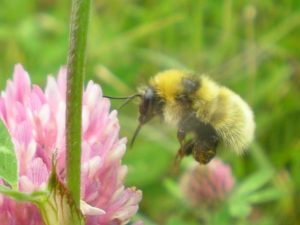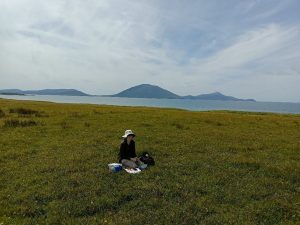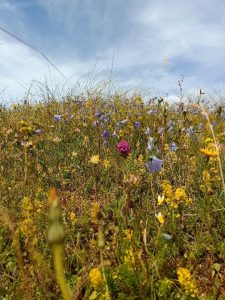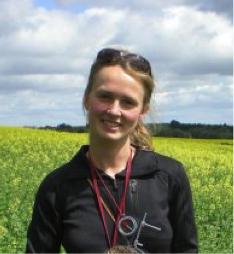By Dr. Dara Stanley, University College Dublin
This blog is part of the ‘Dispatches from Researchers’ series, which features guest articles written by experts in pollination and related fields.

The Great Yellow Bumblebee, Ireland’s rarest true bumblebee, was formally found country wide but is now restricted to the Mullet Peninsula in NW Mayo and the adjacent mainland. A beautiful large bumblebee, predominantly blonde with a characteristic strip along its back, it’s often referred to as a “blonde bombshell”.
The Great Yellow Bumblebee has declined significantly in recent times, which is attributed to changing land use which has resulted in the loss of the species-rich meadows and grasslands it thrives on. It’s now classified as Endangered on the Irish Red List, and vulnerable at the European level.
In recent years we’ve learnt much more about the Great Yellow Bumblebee and what it needs. Increased recording has identified small populations on the mainland and on Achill Island as well as on the Mullet Peninsula, and ongoing genetic work at UCD will give us more information on the health and size of the population, and how much the mainland and peninsula bees interact with each other. Research led by Niamh Phelan confirmed that Great Yellow Bumblebees prefer plants such as Common Knapweed, Kidney Vetch and Red Clover, but that the availability of flowers is lowest when bee numbers are highest. Research by Alex Hayden and Lydia Thompson has shown that delayed mowing and grazing of machair and species rich grasslands on the Mullet benefits bumblebees and may go some way in helping to increase flower numbers at the times of the year they are needed most by the species.

A lot of hard work has taken place to protect the bee. Birdwatch Ireland have managed their nature reserves on the peninsula to benefit the bee for many years, while Belmullet Tidy towns have won awards for their amazing work on pollinators, biodiversity and sustainability. Mayo County Council have supported training and education workshops on the bee for schools and farmers. The National Biodiversity Data Centre have published an excellent guide on measures that can be implemented to help the species.
In 2021 an operational working group involving Belmullet Tidy Towns, Mayo County Council, UCD, Teagasc, Birdwatch Ireland, NPWS, farmers and farm advisors was awarded funding from the Department of Agriculture for the Great Yellow Bumblebee Project. This one-year pilot European Innovation Partnership (EIP) project worked with farmers on the Mullet and Erris mainland to implement management actions that would protect floral resources for the bee. Led by ecologist Karina Dingerkus, the project worked with 27 farmers to implement measures such as delayed grazing and mowing across 46 fields. This resulted in positive feedback from farmers, and the creation of score cards to assess the quality of fields for bumblebees. During monitoring for the project, 1800 bumblebees were recorded including 78 Great Yellows in 17 of the project fields. Many of these farms continue to implement these measures as part of the Life on Machair project, and the operational working group continues to explore new ways to move forwards in the conservation of the species.

The Great Yellow Bumblebee has also become more widely appreciated as part of the culture and heritage of the region. A beautiful mural of the Great Yellow Bumblebee by James Kirwin commissioned by Belmullet Tidy Towns, NPWS and others now holds pride of place on the wall of the handball alley in the centre of Belmullet. A gorgeous bilingual children’s book by Margaret Tallott and Katherine Mangan “The Great Yellow Bumblebee Goes Astray” has also been published to high acclaim. The species has featured on TV and national and local radio and press.
Despite the fantastic work that has taken place, the future of the Great Yellow Bumblebee still remains uncertain. This year hasn’t been a good year for bumblebees including the Great Yellow, but as monitoring for the species is only in its infancy, it’s hard to tell how the population is doing. Despite its endangered status, the Great Yellow Bumblebee has no formal legal protection, which would bring with it additional supports. There is also currently no dedicated funding for conservation work for the bee, and in particular for supporting the farmers who own and manage the habitats it uses. The capacity that has been built through projects to date needs to be supported and grown to expand its reach, to ensure that this beautiful species remains for generations to come.
Dr. Dara Stanley is a Lecturer in Applied Entomology in the School of Agriculture and Food Science, and Earth Institute at University College Dublin.
Find out more:
Helping endangered pollinators: the Great Yellow Bumblebee
Guide: Protecting Rare Pollinators: the Great Yellow Bumblebee

